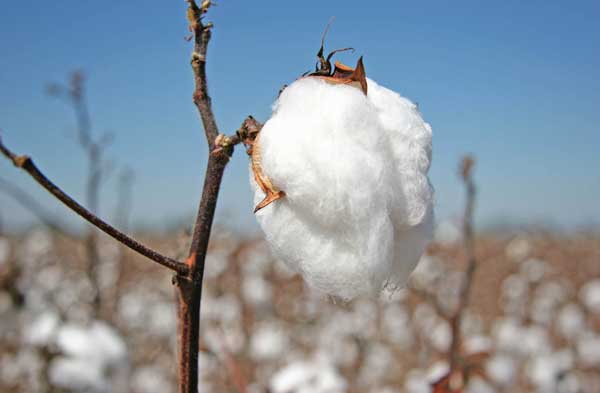July 26, 2012

The drought of 2011 and 2012 has had a major negative impact on cotton in the local area. Yields this year were such that many producers are having their crop adjusted out by Crop Insurance as economics indicated that it was more economical to collect insurance on the adjusted crop yield and destroy the remaining crop rather than harvest the poor crop.
As the cotton harvest nears completion, it is important not to forget about destroying those cotton stalks as soon as the crop has been removed or terminated to aid in reducing costs for the Boll Weevil Eradication Program (BWEP). This year not been one boll weevil was caught in Nueces County, although some have been caught recently just to the south. Good progress has been made on this front, so let’s keep it that way.
The cotton stalk destruction deadline for Nueces County remains September 1, 2012.
In its native habitat cotton is a perennial shrub that may survive for many years. The perennial habit of cotton allows it to re-grow following harvest, and to provide potential for development of hostable fruit (squares and bolls) for boll weevil feeding and reproduction. Under good environmental conditions, cotton plants can generate hostable fruit in three to four weeks. Additionally, cotton stalks destruction will preserve soil moisture for the following season.
When field conditions and weather are favorable for tillage, stalks can be shredded and then disked to destroy the plant. Stubble stalk pullers can also be used to uproot the stalk. These mechanical methods are generally successful, but some stalks may survive these operations. Many growers are implementing reduced tillage systems, which do not allow for primary tillage operations, causing them to evaluate new methods for stalk destruction.
We’ve seen much interest in alternative cotton stalk destruction throughout the South Texas area in recent years. While many producers still use various tillage methods to destroy cotton stubble, be aware that other choices are available. Regardless of the method chosen, the primary purpose of destroying cotton stalks remains the same and that is to prevent cotton fruiting sites (squares or bolls) that are a food source for the boll weevil. These fruiting sites will allow the boll weevil to reproduce and increases its winter survival rate.
Herbicide options
Several herbicides have been registered for cotton stalk destruction. Herbicides available include, but are not limited to, 2, 4-D (ester and amine formulations) and several dicamba products (Weedmaster, Clarity, Banvel). For these products to be legal for cotton stalk destruction, the label must contain a section addressing “crop stubble” or specify cotton as the target pest following harvest.
Based on most recent field research, it appears the low-volatile, amine salt formulations are equally as effective as the ester formulations for cotton stalk destruction, and minimize problems associated with off-target drift. The first application should be at the rate of one pound of active ingredient per acre (1 quart of a 4 pounds active ingredient per gallon formulation). Generally, a second application of 0.5 to 1.0 pound active ingredient per acre will be necessary to control any live stalks and emerged cotton seedlings.
To obtain optimum results, cotton stalks should be shredded (6- to 8-inch height) and the spray application should be made soon after shredding. Best results are achieved if the herbicide is applied the same day as shredding. To achieve optimum effectiveness, some growers have mounted spray booms directly on their flail shredders and are banding their herbicide during the shredding operation, and achieving excellent results.
Note that thorough coverage is essential, and should be in the range of 5 to 10 gallons water per acre. Also, the addition of surfactant at the rate of 0.5 percent v/v (2 quarts per 100 gallons of water) is recommended. Research has shown essentially no difference in killing re-growing cotton plants with 2, 4-D between treating shredded stalks within one day, treating 2 weeks after shredding, or standing stalks. However, other products are less effective on standing stalks.
If a hormone herbicide like 2, 4-D is used, remember there is always the potential for off-target drift that might affect other susceptible crops in the area. So, be careful and monitor local environmental conditions that could promote the off-target movement of the product.
With a lot of lint on the ground this year, a significant rain event will likely generate sprouting cotton seedlings in many fields, possibly allowing floating lint/seed to be washed into ditches and creeks, so we need to be aware of this potential problem and destroy these seedlings when they begin to emerge.
If we do not receive a good rain this summer or fall, we should expect to be fighting volunteer cotton in these fields next spring. For additional information on managing volunteer cotton, refer to http://varietytesting.tamu.edu/cotton/#harvesting
At this web site scroll down to the Weed Section and then select the link for Managing Volunteer Cotton in Grain Crops.
As we work to wrap up another cotton crop, it is important to remember that without an effective cotton stalk destruction program here, boll weevil eradication cannot be accomplished in South Texas.
You May Also Like




